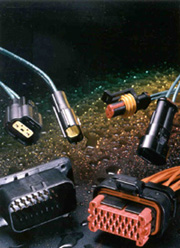 Photo © 1998 AMP INC.
Photo © 1998 AMP INC.Most of the early coppers used for electrical transmission and interconnection are quite conductive, with electrical conductivity ranging upward from 85%. Note the conductivity of Phosphorous Deoxidized Copper; it has a copper content of 99.9%, yet its conductivity is "only" 85% IACS. Phosphorous is one of the elements that severely depress conductivity. Commercially pure copper has 101% IACS (due to improved refining techniques and processing), as do several of the oxygen free (pure) coppers like C10100 and C10200. Percent IACS values are usually published as minimum values for annealed tempers. Tempered (cold-worked) metals may have a minimum value 1 to 3 percentage points below the annealed minimum.
When somewhat higher strength is required, but with maximum conductivity, then certain High Copper alloys using such alloying elements as tellurium, zirconium, magnesium, cadmium(now in disfavor due to its adverse effects on the environment), chromium, and iron, in some cases in combination with phosphorous, are available and can provide conductivity of around 80 to 90%IACS.
Another group of alloys, based on various combinations of additives including boron, iron, tin, zinc, cobalt, magnesium and phosphorous can provide good strength with conductivity in the range of 50 to 75%IACS.
There are number of alloys in the conductivity range from 25 to 50% IACS, including certain beryllium coppers, brasses, tin brasses, phosphor bronzes, and copper-silicon alloys.
Finally, there is a choice of alloys which can provide very high strength with somewhat limited electrical conductivity, typically in the range from less than 10 to nearly 25%IACS. These include the so-called high strength beryllium coppers and the copper-nickel-tin alloys which can be strengthened by precipitation hardening. There are also a number of phosphor bronzes in widespread use, both the traditional work-hardenable alloys and several newer alloys with additional additives to promote dispersion strengthening. There are also aluminum bronzes and copper-nickel alloys, each with its own special capabilities.
